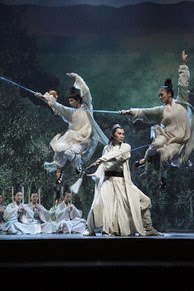ORIGINALLY PUBLISHED IN THE SHIMMY 05 AUGUST 2011
Qing Cheng, starring a husband and wife team as time-crossed lovers, is “the first ever artistic attempt to showcase the Taoist philosophy on stage.” It highlights the particular preoccupations of this rich spiritual tradition. “Take for example the duality of soft versus hard, and the ideas of non-doing, immortality, natural balance, and ultimate quietude," says James Tee Wee. "One will find the teaching of Lao Tzu presented in abundance. The use of tai chi movement, sword technique, calligraphy, chess games, music instruments, and praying rituals on stage are all very representative of Taoism. Even the scenery wagon on stage resemble a pair of Ying and Yang!”
The Ying and Yang is the central image of Taoism, and symbolises the complex relationship between contrasting elements that makes us Taoisms most distinctive – and well-known – concept. Given that “the Tao which can be named is not the Tao,” it is perhaps surprising that theatre has not been quicker to play with its precepts, since it contains that ambiguity that is ideal for a challenging performance.
There is considerable romance alongside the hard thinking: and the abstract philosophy does not disconnect Qing Cheng from hard reality. “It all began with the producer's visit to the devastated city of Dujiangyan after the Sichuan earthquake. Mr LV thought it would be meaningful in creating some intangible asset for the people there. He sourced local folktales, then script writing.”
“What makes it more meaningful is that Tang Zixing and Wang Lida, who play hero Murong and Princess Jade, met in volunteer relief work for the same earthquake! Soon they fell in love, and got married!”
Christian religious art – from Botticelli’s Annunciation to David Mach’s controversial exhibition down near Waverley Station – takes on all manner of forms, but Tee Wee observes that Taoism dictates that its art has a particular quality. “The practitioner has to master their heart and soul. It is not just as simple as controlling them but to subdue all impulses and let the being itself blend very harmoniously with universe.”
As the performance reveals, this philosophy can be found in many arts, but the quality of the artist is, in itself, the ideal being expressed. “One can easily spot a uniqueness in all Taoist arts, which is the feel of harmony. The act can be swift and forceful but the results are always graceful and smooth.”

No comments :
Post a Comment